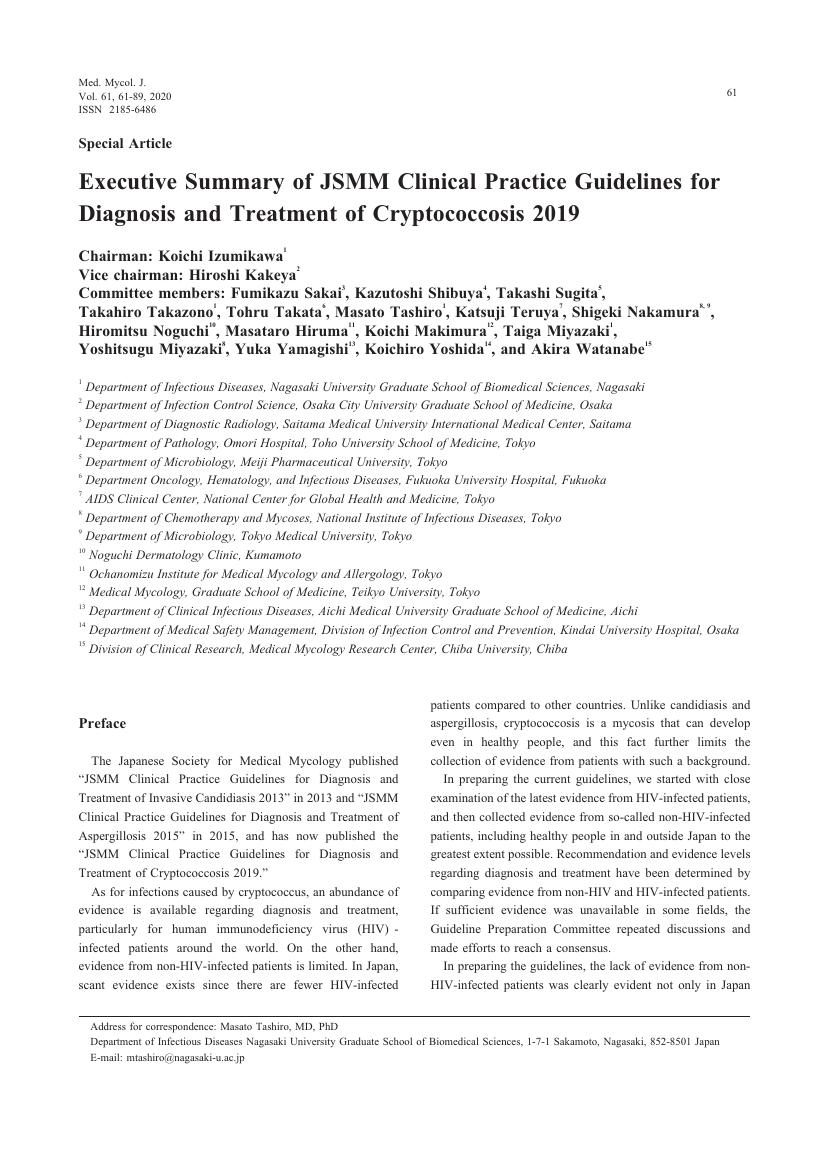- 著者
- Yu GUO Mohamed Mahdi ALSHAHNI Kazuo SATOH Takashi TAMURA Rima Zakzuk ALSHAHNI Koichi MAKIMURA
- 出版者
- JAPANESE SOCIETY OF VETERINARY SCIENCE
- 雑誌
- Journal of Veterinary Medical Science (ISSN:09167250)
- 巻号頁・発行日
- vol.85, no.3, pp.271-278, 2023 (Released:2023-03-01)
- 参考文献数
- 29
Koalas are iconic mammals indigenous to Australia. These rare animals and their habitats are occasionally associated with pathogenic fungi, including species of Cryptococcus, and consequently, monitoring the mycobiota of areas inhabited by koalas is of considerable importance. In this report, we describe a novel basidiomycetous yeast isolated from a site in Kanazawa Zoo, Japan, associated with captive koalas. Swab samples were collected from koala breeding environments, from which we isolated a novel unencapsulated yeast characterized by ovoid to ellipsoidal cells (3.2–4.9 × 3.5–5 μm). These cells were observed to undergo polar budding and grow as parent bud pairs, with an optimal growth temperature of 28°C. Colonies grown on yeast extract peptone dextrose agar at 28°C have a characteristic coral pink color. On the basis of physiological, morphological, and molecular characters, the new species was placed in the genus Begerowomyces, and the name Begerowomyces aurantius JCM33898T(LSEM1333T=CBS16241T) is proposed.
- 著者
- Koichi Izumikawa Hiroshi Kakeya Fumikazu Sakai Kazutoshi Shibuya Takashi Sugita Takahiro Takazono Tohru Takata Masato Tashiro Katsuji Teruya Shigeki Nakamura Hiromitsu Noguchi Masataro Hiruma Koichi Makimura Taiga Miyazaki Yoshitsugu Miyazaki Yuka Yamagishi Koichiro Yoshida Akira Watanabe
- 出版者
- The Japanese Society for Medical Mycology
- 雑誌
- Medical Mycology Journal (ISSN:21856486)
- 巻号頁・発行日
- vol.61, no.4, pp.61-89, 2020 (Released:2020-11-30)
- 参考文献数
- 39
- 被引用文献数
- 7
- 著者
- Nobuyasu Yamaguchi Michael Roberts Sarah Castro Cherie Oubre Koichi Makimura Natalie Leys Elisabeth Grohmann Takashi Sugita Tomoaki Ichijo Masao Nasu
- 出版者
- 日本微生物生態学会 / 日本土壌微生物学会 / Taiwan Society of Microbial Ecology / 植物微生物研究会
- 雑誌
- Microbes and Environments (ISSN:13426311)
- 巻号頁・発行日
- pp.ME14031, (Released:2014-08-12)
- 被引用文献数
- 8 81 1
Previous space research conducted during short-term flight experiments and long-term environmental monitoring on board orbiting space stations suggests that the relationship between humans and microbes is altered in the crewed habitat in space. Both human physiology and microbial communities adapt to spaceflight. Microbial monitoring is critical to crew safety in long-duration space habitation and the sustained operation of life support systems on space transit vehicles, space stations, and surface habitats. To address this critical need, space agencies including NASA(National Aeronautics and Space Administration), ESA (European Space Agency), and JAXA (Japan Aerospace Exploration Agency) are working together to develop and implement specific measures to monitor, control, and counteract biological contamination in closed-environment systems. In this review, the current status of microbial monitoring conducted in the International Space Station (ISS) as well as the results of recent microbial spaceflight experiments have been summarized and future perspectives are discussed.
- 著者
- Kazuo GOTO Mikachi YAMAMOTO Miwa ASAHARA Takashi TAMURA Mitsuru MATSUMURA Nobuhito HAYASHIMOTO Koichi MAKIMURA
- 出版者
- JAPANESE SOCIETY OF VETERINARY SCIENCE
- 雑誌
- Journal of Veterinary Medical Science (ISSN:09167250)
- 巻号頁・発行日
- pp.1204080808, (Released:2012-04-13)
- 被引用文献数
- 3 12
Mycoplasma species identification is based on biochemical, immunological, and molecular methods that require several days for accurate identification. Matrix-assisted laser desorption ionization time-of-flight mass spectrometry (MALDI-TOF MS) is a novel method for identification of bacteria and has recently been introduced into the clinical microbiology laboratory as a rapid and accurate technique. This method allows a characteristic mass spectral fingerprint to be obtained from whole inactivated mycoplasmal cells. In this study, we evaluated the performance of the MALDI-TOF MS for the identification of Mycoplasma by comparison with standard sequence analysis of 16S rRNA. We developed the first database of MALDI-TOF MS profiles of Mycoplasma species, containing Mycoplasma pulmonis, M. arthritidis, and M. neurolyticum, which are the most common pathogens in mice and/or rats, and species-specific spectra were recorded. Using the database, 6 clinical isolates were identified. Six tracheal swabs from 4 mice and 2 rats were cultured on PPLO agar for 4 to 7 days, and the colonies were directly applied to analyze the protein profiles. Five strains were identified as M. pulmonis, and 1 strain from a mouse was identified as M. neurolyticum (spectral scores were >2.00); the results were consistent with the results of the 16S rRNA gene sequence analysis (homologies>97.0%). These data indicate that MALDI-TOF MS can be used as a clearly rapid, accurate, and cost-effective method for the identification of M. pulmonis isolates, and this system may represent a serious alternative for clinical laboratories to identify Mycoplasma species.
